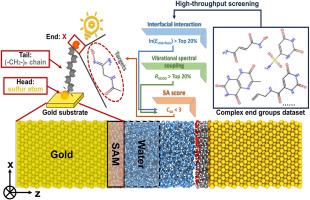通过简单物理指标的平行筛选,高效设计自组装单层膜以增强固水界面的导热性
IF 5.8
2区 工程技术
Q1 ENGINEERING, MECHANICAL
International Journal of Heat and Mass Transfer
Pub Date : 2025-09-13
DOI:10.1016/j.ijheatmasstransfer.2025.127815
引用次数: 0
摘要
固体-水界面热传递在微纳尺度上是至关重要的,在热器件和纳米流体中有着重要的应用。自组装单层(SAMs)功能化材料表面可以桥接固水界面,减少振动不匹配,从而提高界面热导率(ITC)。然而,目前对SAM热输运调控的研究仅涉及简单结构,数据较少,对复杂SAM端基结构的高通量(HTP)发现尚未见报道。这项工作提出了一个高效的设计框架,通过使用与ITC相关的简单物理指标并行筛选SAM端群。与通过对所有相关材料进行全面模拟获得ITC相比,本文计算了金水界面处SAMs中250个复杂端基结构的界面相互作用能和振动谱耦合强度,并整合ML模型对另外750个复杂候选物进行了多目标筛选。最终,通过完全非平衡分子动力学(NEMD)模拟,发现了9个ITC大于150 MW/(m2K)、合成可达性得分低于3分的SAM端基结构,ML模型的筛选成功率超过85%。通过库仑和范德华相互作用的热输运分解分析,具有极高ITC的SAM可归因于与水分子的高极性端基的强库仑相互作用。该HTP框架填补了ITC调控中SAM端基HTP筛选研究的空白。此外,相关的计算数据将有助于未来的数据驱动的地对空导弹研究。本文章由计算机程序翻译,如有差异,请以英文原文为准。

High-efficiency design of self-assembled monolayers for enhanced thermal conductance at solid-water interfaces via parallel screening with simple physical metrics
Solid-water interfacial thermal transport is crucial at the micro-nano scale and has important applications in thermal devices and nanofluids. Functionalizing material surfaces with self-assembled monolayers (SAMs) can bridge the solid-water interfaces, reduce vibrational mismatches, and thereby enhancing interfacial thermal conductance (ITC). However, existing research on SAM thermal transport regulation only involves simple structures with scarce data, and high-throughput (HTP) discovery for complex SAM end group structures have not been reported. This work proposes a high-efficiency design framework for SAM end groups through parallel screening using simple physical indicators associated with ITC. Compared to obtain ITC through full simulations of all the relevant materials, here we calculate the interfacial interaction energy and vibrational spectral coupling strength of 250 complex end group structures in SAMs at gold-water interface and integrate ML models to perform multi-objective screening on another 750 complex candidates. Ultimately, through complete nonequilibrium molecular dynamics (NEMD) simulations, 9 SAM end group structures with ITC higher than 150 MW/(m2K) and the synthetic accessibility scores below 3 were discovered, which the ML models screening success rate exceeding 85%. Through thermal transport decomposition analysis of Coulombic and van der Waals interactions, the SAM with extremely high ITC can be attributed to strong Coulombic interactions with water molecules due to highly polar end groups. This HTP framework fills the gap in research on HTP screening of SAM end groups for ITC regulation. Additionally, the related computational data will contribute to future data-driven research on SAMs.
求助全文
通过发布文献求助,成功后即可免费获取论文全文。
去求助
来源期刊
CiteScore
10.30
自引率
13.50%
发文量
1319
审稿时长
41 days
期刊介绍:
International Journal of Heat and Mass Transfer is the vehicle for the exchange of basic ideas in heat and mass transfer between research workers and engineers throughout the world. It focuses on both analytical and experimental research, with an emphasis on contributions which increase the basic understanding of transfer processes and their application to engineering problems.
Topics include:
-New methods of measuring and/or correlating transport-property data
-Energy engineering
-Environmental applications of heat and/or mass transfer

 求助内容:
求助内容: 应助结果提醒方式:
应助结果提醒方式:


